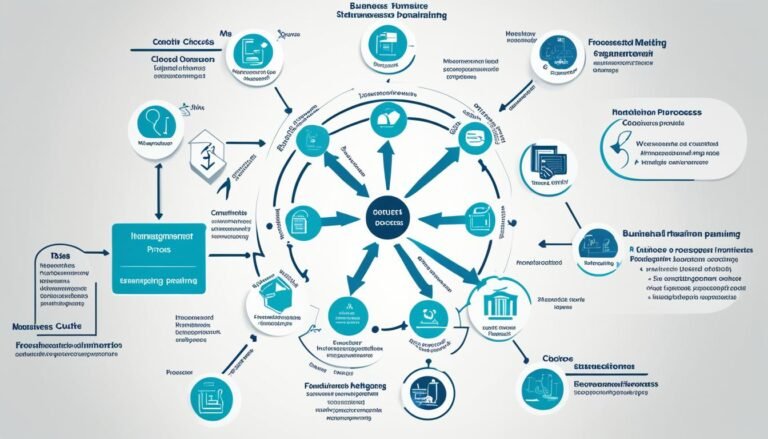How do managers handle multiple concurrent projects effectively?
Did you know 70% of project managers tackle multiple projects at the same time? It’s true. Today’s workplaces are fast-paced, making it necessary for managers to manage several tasks. This means they have to balance many priorities, deadlines, and resources.
This article will dive into project management strategies, time management tips for managers, effective project prioritization, and more. It’s filled with insights and best practices for project managers, new and experienced. They will guide you in managing multiple projects efficiently and meeting your goals.
Key Takeaways:
- Implement effective project management strategies to maximize productivity.
- Master the art of time management to efficiently juggle multiple projects.
- Prioritize projects based on their impact on company goals.
- Empower your team to adapt to changing priorities.
- Utilize project management tools and software for streamlined project management.
Plan and manage all projects in one place
Lack of visibility can make managing projects hard. Using one spot to plan all projects helps. This can be a multi-project management tool or platform.
Managers can track all projects better this way. They can see each project’s progress and spot problems. This tool is like a main place where everyone working on the project can come to see updates.
This method also lets managers see project updates in real time. They can tell which tasks are done, being worked on, or late. This way, they can fix problems before they get big.
Having all projects in one place makes sharing work fair. Managers can know who’s free and give tasks to those people. This helps the team not get too busy with too many projects.
Plus, it makes the team communicate better too. They can talk, share files, and update each other on the project. This boosts teamwork and makes the project run smoother.
So, using a multi-project tool or platform makes managing simpler. It makes seeing how every project is doing easier. This leads to better resource use and team collaboration. All in all, it helps all projects finish well and on time.
Clearly define goals, plans, and responsibilities
Projects can turn upside down without clear goals, plans, and responsibilities. Managers should set a standard path to follow. This makes sure everyone knows what to do and why.
To start, define what each team should aim for. This should match up with what the whole company wants. By doing this, each project plays a part in reaching the big company goals. So, everybody’s work matters.
“Having a clear project planning process in place helps mitigate inconsistencies in deliverables and processes. It serves as a guide for the team and allows for better coordination and collaboration.”
Getting everyone on the same page is key. Talk with the important people and the team. This makes sure they understand and agree with the plan. This way, everyone feels part of the team and tries harder to reach the goal.
A good workflow includes clear steps and checkmarks. This makes sure everyone can see the progress. It also helps to catch mistakes early.
Clear goals, plans, and duties lay the path for success. People work better when they know where they are going. This way, the team stays happy and the project heads the right way.
Example:
A visual representation of a standard workflow helps team members understand the steps involved in a project and provides clarity on their individual roles and responsibilities.
Prioritize the work that will make the most impact
When you’re handling several projects, it’s key to pick the ones that matter most. This means focusing on tasks that help the company achieve its goals. By doing this, managers make sure their work adds real value to the company.
Looking at project priorities happens in two ways. First, at a big-picture level, managers consider how each project fits with the company’s main goals. They look at what will truly push the company forward.
Then, on a smaller scale, they examine each project’s specific objectives. They figure out what matters most, like deadlines and the project’s impact on other work. This helps them decide where to put their efforts most effectively.
A methodical approach to setting project priorities is crucial. It lets managers use their resources well, concentrate on what achieves the best results, and prevent overloading themselves. Following this method ensures the company’s goals stay on track and move closer to success.
| Project | Alignment with Company Goals | Impact on Company Goals |
|---|---|---|
| Project A | High | High |
| Project B | Low | Medium |
| Project C | High | Low |
Effective project prioritization involves evaluating the alignment of each project with the company’s overarching goals and determining the potential impact it will have on those goals. By prioritizing the work that will make the most impact, managers can ensure that their efforts are contributing to the company’s success.
Empower your team to be flexible when priorities change
Dealing with several projects means you must be ready to adjust when priorities change. Empower your team to handle these shifts well. This ensures projects flow smoothly. Here are some important strategies for being flexible:
- Implement a Change Control Process: Start a method to keep track of priority changes. This process lets you review and okay changes. It makes sure all changes help reach the project’s main goals and the company’s overall aims.
- Maintain Open Communication: Create a space where sharing updates and worries is easy. Ask for updates often and hold meetings where everyone can share their thoughts. Make sure everyone knows about any changes in project needs or deadlines.
- Utilize Flexible Resource Allocation: Adjusting how you use resources is critical when priorities switch. Knowing your team’s skills, workloads, and who’s available helps. It lets you change how you use resources to fit new project needs. This helps work smoothly and avoids any issues that could slow things down.
- Track Shifting Priorities: Use tools and software to follow changes in priorities. These tools show how each project is doing, spot areas that need help, and help with resource management. Watching and managing changes in priorities can prevent delays in project timing and outcomes.
Being flexible and helping your team adjust makes a big difference in dealing with project changes. Next, we’ll look at why being clear about what’s expected and communicating well are vital in managing many projects.
Manage and communicate expectations clearly
It’s key to talk well when you’re handling lots of projects. To be sure everyone’s on the same page, managers should make their expectations clear. They do this by regularly updating everyone and keeping communication open. This way, everyone knows how things are going and what’s happening with the project.
Using a central platform makes communication clear. This is a place where everyone can see how the work is going at any time. It’s like a meeting point where the team leader shares updates. With everyone seeing the same facts, there are fewer misunderstandings. This means stakeholders understand the project’s progress and goals better.
Talking openly also means being real about what can be achieved and when. When these expectations are set from the start, the whole team knows what to shoot for. Everyone understands their part in reaching the project’s finish line.
“Good communication does not just happen; it requires effort and a commitment to keeping everyone informed.” – John Maxwell
Benefits of clear communication:
- Reduces misalignment with stakeholders
- Improves visibility into work progress
- Enables real-time updates and informed decision-making
- Fosters collaboration and effective teamwork

Good communication helps avoid misunderstandings. On top of that, it lets everyone see the work progress in real-time. By doing so, managers make their teams more efficient and make sure projects succeed better. Everyone stays in the loop better, which is key to getting things done right.
Monitor employee workloads across projects
Managing workloads is key for those overseeing several projects. It’s vital for a smooth project flow and to dodge overloads or clashes. They must keep a close eye on how tasks are shared and met.
Delegating tasks evenly is crucial. It helps to not overload anyone and brings out the best in each team member. This way, work moves along faster and more efficiently.
But, just giving out tasks won’t solve everything. Managers must also see how the work is spread out and if there are issues. This overview helps them tweak work assignments and move resources as needed.
Task Delegation and Collaborative Platforms
Project management platforms make assigning work easier. They offer a central place for tasks, deadlines, and progress tracking.
They also show how much work everyone has, helping find and fix any issues before they cause trouble.
“Keeping watch over employee workloads means using resources better and avoiding project timeline clashes. It helps managers decide who should do what based on data.” – Sarah Jones, Project Manager at XYZ Company
Benefits of Workload Visibility
Seeing everyone’s workload offers many pluses:
- It stops burnout by avoiding too much work for some.
- It makes managing project timelines easier by spotting problems early.
- It improves task delegation by letting managers use team members’ skills well.
- It aids in using resources wisely by pointing out where more or less is needed.
Real-Time Workload Monitoring
Watching work in real time keeps everything in check with project demands. Systems that update and alert right away are a big help. They let managers see how tasks are going and make quick changes if needed.
Actively checking how much everyone is doing avoids work pile-ups or missed tasks. It keeps the workplace healthy, cuts delays, and makes sure every project succeeds.
Adjust project schedules to maximize team productivity
Proper project scheduling is key to making the most of your team’s efforts. It helps avoid giving too much work to some team members. This way, everyone has a fair amount to do. Teams also need a plan to handle any surprises during a project.
Managers need to look at when their team can start new projects. They should make sure each team member has enough time to work on their tasks. This stops problems from slowing things down, making work go smoothly.
“By coordinating project start dates, managers can avoid overloading team members and ensure a balanced workload.”
Having a plan for unexpected things is vital too. This plan guides what to do if a problem comes up. It helps teams solve issues quickly and keep the project moving forward.
Efreflectioniently managing schedules means planning well and checking often. It’s about keeping things on time and within the planned budget. Staying in touch with everyone involved keeps things clear and on track.
Benefits of Adjusting Project Schedules:
- Maximizes team productivity by avoiding workload overloading
- Optimizes resource allocation and ensures balanced work distribution
- Enables prompt response to unexpected incidents with an incident management plan
- Allows for flexibility and adaptability in addressing shifting priorities
- Enhances overall project efficiency and timely completion
By managing schedules well and having plans in place for bumps in the road, managers set their teams up for success.
Set up a Project Management Office (PMO)
Creating a Project Management Office (PMO) is a smart step. It can really boost how projects are managed, how well people communicate, and how closely standards are followed. A PMO is like a main station for keeping projects in check, offering the needed tools and help for smooth sailing.
With a special team or an outside group, companies can make sure their projects run smoothly. A PMO makes talking to each other clearer among those involved. This teamwork cuts down on misunderstandings that could slow a project down.
One big plus of having a PMO is it enforces how projects are done. It uses set ways, tools, and guides to keep projects on track from start to finish. This makes it more likely that all projects will be done well and on time, making the company look good.
A PMO also keeps a sharp eye on all project groups. It watches each project’s progress, spots possible troubles, and fixes them fast. This big-picture look lets project leaders make smart choices, use resources wisely, and juggle different project needs.
Additionally, a PMO is where the company keeps all its project wisdom and advice. It saves the best ways to work from past projects and shares what went wrong to learn from it. This lets future projects be even better and avoid known mistakes.
In the end, starting a Project Management Office (PMO) makes companies better at handling projects. It makes project managing, talking to each other, and sticking to the plan stronger. With a PMO in place, organizations can steer many projects well and bring success to their project lineup.
Use Project Management Software
Managing lots of projects can get hard, but project management software makes things easier. It has tools that help organize work. This way, managers can make sure each project is a success.
The portfolio dashboard is a top feature in these software platforms. It gives a quick look at all the projects, showing their status. This helps managers keep everything on the right track.
Dealing with who does what is another important part. Using project management software, a manager can easily hand out tasks. They can also see how much work each team member has, avoiding overloading anyone. This keeps the work balanced and the team happy.
Watching the progress of each project becomes easy with this software. Instead of asking for updates, managers can see the deadlines and how far along tasks are. This way, everyone knows where things stand, making work smoother.
There are many benefits to using project management software. It makes managing projects easier with things like the dashboard, organized resource use, and easy progress checks. This software is great for anyone handling a lot of projects.
Comparison of Project Management Software
| Feature | Software A | Software B | Software C |
|---|---|---|---|
| Portfolio Dashboard | ✓ | ✓ | ✓ |
| Resource Allocation | ✓ | ✓ | ✓ |
| Progress Monitoring | ✓ | ✓ | ✓ |
| Collaboration Tools | ✓ | ✓ | ✓ |
| Task Management | ✓ | ✓ | ✓ |
Conclusion
Handling several projects at once needs great project skills, good time management, and clear talks. By using the strategies we’ve discussed, managers can tackle several projects at a time. This boosts how much work gets done and makes sure projects succeed.
It’s crucial to plan well and know what comes first. Using a tool or platform to see all projects at once is very helpful. Setting clear goals, planning projects, and assigning tasks helps keep everything on track towards the same goals.
Managers must be clear about what they expect and keep everyone updated. Talking openly and sharing updates in a central place helps. It keeps everyone moving in the same direction. Managing workloads and being adaptable when priorities change are also key steps.
To wrap up, managing multiple projects needs a big-picture strategy. It includes using the right techniques, software, and keeping everyone informed. With these steps, managers can handle the challenges of multiple projects. They can lead their teams to do great work, benefiting their companies.
FAQ
How can managers effectively handle multiple concurrent projects?
Managers can effectively handle many projects at once by using certain strategies. These include setting priorities, giving power to their team members, and using special software.
How can managers plan and manage all projects in one place?
To have all projects in one spot, managers should use special tools. These tools or platforms give a clear view of everything happening across projects.
How can managers clearly define goals, plans, and responsibilities?
Setting clear goals and plans is key. Using a standard project planning process helps. Also, communicating team objectives clearly is important.
How should managers prioritize the work that will make the most impact?
Managers must put the most important work first. They do this by focusing on what matters most to the company’s goals. Prioritization works on both big and small parts of the project.
How can managers empower their teams to be flexible when priorities change?
Empowering teams to flex with changing priorities involves several steps. These include a change control process, always talking openly, and a flexible way to assign resources.
How can managers manage and communicate expectations clearly?
To keep expectations clear, managers should update everyone on progress in real time. This means sharing information in one place. Plus, always keeping communication open with the team and stakeholders is vital.
How can managers monitor employee workloads across projects?
By delegating well and balancing the work, managers can keep track of their teams’ loads. They should also be able to see everyone’s tasks and deadlines in one view.
How can managers adjust project schedules to maximize team productivity?
Maximizing productivity means adjusting project schedules correctly. Managers should make sure the start dates don’t clash, keep resources balanced, and have a plan for unexpected issues.
How can managers set up a Project Management Office (PMO) to enhance project management control and communication?
Setting up a PMO boosts control and communication for the whole project. It becomes a core place for all project coordination and standards.
How can managers benefit from using Project Management Software?
Project Management Software gives managers great tools. These tools include dashboards, resource tracking, and monitoring progress. They help keep all projects in check from one place.
What are some best practices for managing multiple projects effectively?
Managing multiple projects well involves some key practices. These can be project strategies, setting clear priorities, and giving power to teams. Also, using the right software is crucial for success.








